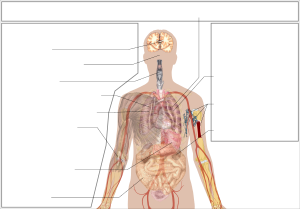
Back Koronavirussiekte-2019 Afrikaans ኮቪድ 19 Amharic 新冠肺炎 AMI COVID-19 AN Wuhanes feforadl ANG कोरोनावायरस रोग 2019 ANP مرض فيروس كورونا 2019 Arabic كوڤيد-19 ARY كوڤيد-19 ARZ কৰ'নাভাইৰাছ ৰোগ ২০১৯ Assamese
The English used in this article or section may not be easy for everybody to understand. (April 2024) |
| Coronavirus disease 2019 (COVID-19) | |
|---|---|
| Other names | COVID, (the) coronavirus |
 | |
| COVID-19 symptoms | |
| Pronunciation | |
| Medical specialty | Infectious disease |
| Symptoms | Fever, cough, tiredness (fatigue), shortness of breath, vomiting, loss of taste or smell; sometimes without any symptoms[1][2] |
| Complications | Pneumonia, viral sepsis, acute respiratory distress syndrome, kidney failure, cytokine release syndrome, respiratory failure, pulmonary fibrosis, pediatric multisystem inflammatory syndrome, chronic COVID syndrome |
| Usual onset | 2-14 days (typically 5) from infection |
| Duration | 5 days to 10+ months known |
| Causes | SARS-CoV-2 |
| Diagnostic method | rRT-PCR testing, CT scan, Rapid antigen test |
| Prevention | Face coverings, quarantine, physical/social distancing, ventilation, hand washing,[3] vaccination[4] |
| Treatment | Symptomatic and supportive |
| Frequency | 776,695,852 confirmed cases |
| Deaths | 7,072,496 |
Coronavirus disease 2019 or (COVID-19) is an infectious disease caused by the coronavirus SARS-CoV-2.[5] This virus is kind of like the older SARS virus.[6][7][8]
The virus SARS-CoV-2 is the cause of the COVID-19 pandemic.[9][10] People who catch COVID-19 may get a fever, dry cough, fatigue, (extreme tiredness) loss of taste or smell, or trouble breathing. Sore throat, runny nose, and cough are also common.[11][12][13][9] COVID-19 has killed more than six million people around the world.[14]
5 to 50 percent of people who get the disease, COVID-19, will get Long COVID.[15]
The COVID-19 virus, SARS-CoV-2, goes from one person to another by droplets. It can also go from one person to another by small airborne particles. Droplets and particles are made when a person breathes, sneezes, or talks.[16][17][18][19]
- ↑ "Symptoms of Coronavirus". U.S. Centers for Disease Control and Prevention (CDC). 13 May 2020. Archived from the original on 17 June 2020. Retrieved 18 June 2020.
- ↑ "Q&A on coronaviruses (COVID-19)". World Health Organization (WHO). 17 April 2020. Archived from the original on 14 May 2020. Retrieved 14 May 2020.
- ↑ Nussbaumer-Streit B, Mayr V, Dobrescu AI, Chapman A, Persad E, Klerings I, et al. (April 2020). "Quarantine alone or in combination with other public health measures to control COVID-19: a rapid review". The Cochrane Database of Systematic Reviews. 4 (4): CD013574. doi:10.1002/14651858.CD013574. ISSN 1464-780X. PMC 7141753. PMID 32267544.
- ↑ "COVID-19 vaccines". World Health Organization (WHO). Archived from the original on 3 March 2021. Retrieved 3 March 2021.
- ↑ "Naming the coronavirus disease (COVID-19) and the virus that causes it". www.who.int. World Health Organization. Archived from the original on 2020-02-28. Retrieved 2020-02-28.
- ↑ World Health Organization (February 11, 2020). Novel Coronavirus (2019-nCoV): situation report, 22 (PDF) (Report). World Health Organization.
- ↑ Gorbalenya AE (2020-02-11). "Severe acute respiratory syndrome-related coronavirus – The species and its viruses, a statement of the Coronavirus Study Group". bioRxiv: 2020.02.07.937862. doi:10.1101/2020.02.07.937862. S2CID 214317727. Archived from the original on 11 February 2020. Retrieved 11 February 2020.
- ↑ "Coronavirus disease named Covid-19". BBC News. 2020-02-11. Archived from the original on 11 February 2020. Retrieved 2020-02-11.
- ↑ 9.0 9.1 Hui, D. S.; I. Azhar E.; Madani, T. A.; Ntoumi, F.; Kock, R.; Dar, O.; Ippolito, G.; Mchugh, T. D.; Memish, Z. A.; Drosten, Christian; Zumla, A.; Petersen, E. (February 2020). "The continuing 2019-nCoV epidemic threat of novel coronaviruses to global health—The latest 2019 novel coronavirus outbreak in Wuhan, China". Int J Infect Dis. 91: 264–66. doi:10.1016/j.ijid.2020.01.009. PMC 7128332. PMID 31953166.
- ↑ "Q&A on coronaviruses". World Health Organization (WHO). Archived from the original on 20 January 2020. Retrieved 27 January 2020.
- ↑ Saniasiaya J, Islam MA (April 2021). "Prevalence of Olfactory Dysfunction in Coronavirus Disease 2019 (COVID-19): A Meta-analysis of 27,492 Patients". The Laryngoscope. 131 (4): 865–878. doi:10.1002/lary.29286. ISSN 0023-852X. PMC 7753439. PMID 33219539.
- ↑ Saniasiaya J, Islam MA (November 2020). "Prevalence and Characteristics of Taste Disorders in Cases of COVID-19: A Meta-analysis of 29,349 Patients" (PDF). Otolaryngology–Head and Neck Surgery. 165 (1): 33–42. doi:10.1177/0194599820981018. PMID 33320033. S2CID 229174644.
- ↑ Agyeman AA, Chin KL, Landersdorfer CB, Liew D, Ofori-Asenso R (August 2020). "Smell and Taste Dysfunction in Patients With COVID-19: A Systematic Review and Meta-analysis". Mayo Clin. Proc. 95 (8): 1621–1631. doi:10.1016/j.mayocp.2020.05.030. PMC 7275152. PMID 32753137.
- ↑ "COVID-19 map - Johns Hopkins Coronavirus Resource Center". Johns Hopkins University. Archived from the original on 12 September 2021. Retrieved 6 February 2023.
- ↑ Ledford H (June 2022). "How common is long COVID? Why studies give different answers". Nature. 606 (7916): 852–853. Bibcode:2022Natur.606..852L. doi:10.1038/d41586-022-01702-2. PMID 35725828. S2CID 249887289.
- ↑ Wang CC, Prather KA, Sznitman J, Jimenez JL, Lakdawala SS, Tufekci Z, Marr LC (August 2021). "Airborne transmission of respiratory viruses". Science. 373 (6558). doi:10.1126/science.abd9149. PMC 8721651. PMID 34446582.
- ↑ Greenhalgh T, Jimenez JL, Prather KA, Tufekci Z, Fisman D, Schooley R (May 2021). "Ten scientific reasons in support of airborne transmission of SARS-CoV-2". Lancet. 397 (10285): 1603–1605. doi:10.1016/s0140-6736(21)00869-2. PMC 8049599. PMID 33865497.
- ↑ Bourouiba L (13 July 2021). "Fluid Dynamics of Respiratory Infectious Diseases". Annual Review of Biomedical Engineering. 23 (1): 547–577. doi:10.1146/annurev-bioeng-111820-025044. hdl:1721.1/131115. PMID 34255991. S2CID 235823756. Retrieved 7 September 2021.
- ↑ Stadnytskyi, Valentyn; Bax, Christina E.; Bax, Adriaan; Anfinrud, Philip (2 June 2020). "The airborne lifetime of small speech droplets and their potential importance in SARS-CoV-2 transmission". Proceedings of the National Academy of Sciences. 117 (22): 11875–11877. Bibcode:2020PNAS..11711875S. doi:10.1073/pnas.2006874117. PMC 7275719. PMID 32404416.